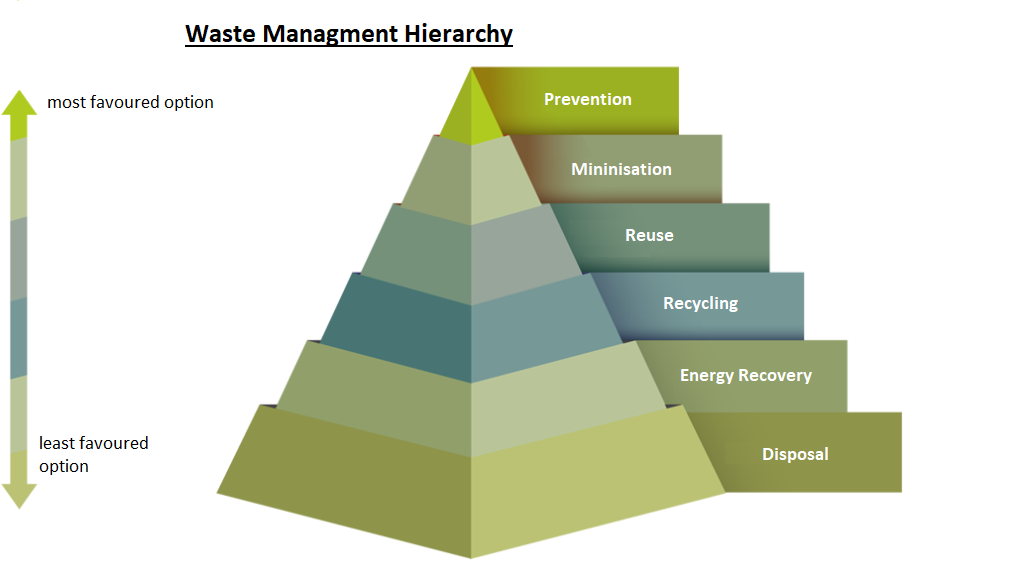The principles of Reduce, Reuse and Recycle, also known as “RRR”, together with energy recovery and disposal, are the five steps in the waste management hierarchy in the European Union. . These five steps are prioritized based on a preference scale for how waste is managed as shown in the pyramid below:

The closer to the top edge of the pyramid there is a way of waste management the more desirable it is. Therefore, according to the hierarchy, the most desirable actions are reduction, reuse and recycling and clearly precede energy recovery and disposal. At the same time, the practical adoption of the hierarchy suggests that through the prevention and reuse of products, more and more waste will be available to be taken to the next stages of management. That is, the more we reduce the waste we produce the less waste is eventually led to recycling, energy recovery or disposal.
Mininisation
It is therefore clear that the best and most economical choice among waste management methods is to “prevent” and “reduce” the waste generated. The best waste is the one that was never produced. The effort to reduce waste production is increasingly influencing the policies of the European Union and therefore of the Member States on waste management. Basic ways to reduce waste production are ecological product design and educating consumers for more responsible consumer action. Responsible consumer action means buying smarter only the products we need, and choosing more durable products or products that are created from recyclable materials or that are more easily recycled or that have less packaging.
Reuse
By “reuse” we mean the use of a material or object again, either for the original purpose, or for a similar purpose for which it was created, without significantly altering the physical form of the material or object. With reuse we consume less resources than recycling and therefore reuse as a solution for waste management is preferred to recycling. Examples of reuse are the use of a bag, or a jar more than once, the repair of electronic equipment and the repair of clothes, shoes and furniture.
Recycling
By “recycling” waste is used as a raw material to create new products, thus saving raw materials and energy in relation to the re-creation of the same or similar products. In other words, it is the conversion of products into secondary raw materials which are utilized in the production of new products, avoiding the waste of primary raw materials.
Waste has traditionally been considered a source of pollution and its main disposal has been disposal. The economy worked and still works in many countries according to the “take – make – consume – discard” model, which is a linear model where every product inevitably sooner or later reaches the end of its useful life. For the manufacture of food and consumer goods, for example, valuable materials are used, which with this model are discarded as soon as the products they contain are consumed. This economic model is based mainly on the extraction of resources with the consequent over-exploitation and degradation of the environment.
The transition to a circular economy with the aim of achieving sustainable development is therefore more necessary than ever. The key to a circular economy is to view waste as a resource and no longer as waste. What was previously considered “waste” is a source of secondary raw material. The concept of circular economy is based on the way natural ecosystems work, in which there is no waste as it reaches the end of its life cycle, it is some form of raw material for another organism, or process.
Similarly, in such an economy the products are designed to fit into material cycles, so that their added value is maintained as much as possible and the residual waste is close to zero. Therefore, the main objectives of this new vision are to limit the disposal of materials (landfill) while simultaneously boosting the reduction, reuse and recycling of products at the end of their life. Achieving these goals requires actions such as:
- Stimulating innovation in the field of recycling
- Providing incentives for better product design
- The creation of markets for secondary raw materials
- The creation of networks for the collection and management of products at the end of their life
- Encouraging preference for products made in part or in whole from secondary raw materials
- The change in consumer behavior and especially in the way they buy and the way they arrange the fate of products at the end of their life cycle.



